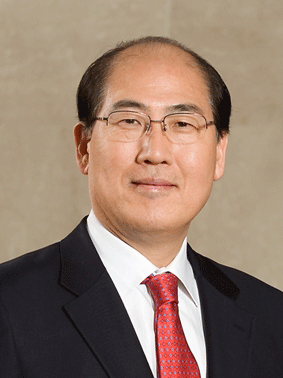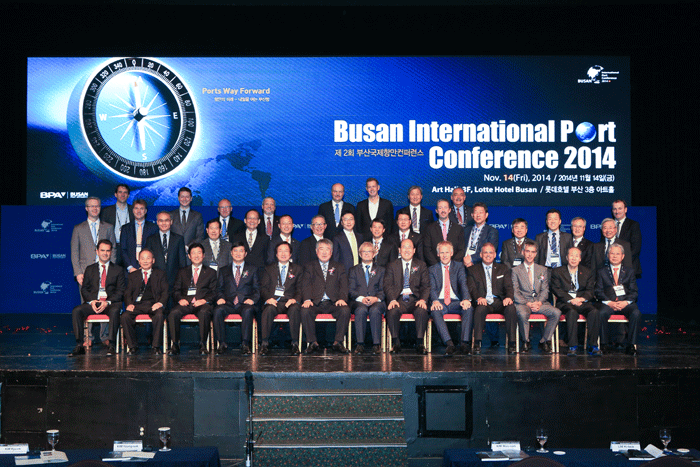On the them of ‘Ports Way Forward’
Following the first conference held in 2013, the Busan Port Authority, which operates the fifth largest container port in the world, hosted the Busan International Port Conference (BIPC) 2014 on Nov. 14, 2014 at Lotto Hotel Busan under the theme of ‘Ports Way Forward’ with three working sessions of port governance, dock labor, and port redevelopment. As an international conference launched marking the 10th anniversary of Busan Port Authority’s foundation last year, the conference this year was held to enhance global brand and international capability of Busan Port by reinforcing its leading role in the global shipping and port industry.

In the opening ceremony, President Lim Ki-tack of Busan Port Authority delivered welcoming address, and Mayor Shu Byung-soo of Busan Metropolitan City and other ranking officials made congratulatory remarks. Ambassador Rolf Mafael of the Federal Republic of Germany to Korea delivered a keynote speech, and it was followed by a special lecture by Tim Power, Director and Head of Maritime Advisor, Drewry, on the topic ‘Global Shipping Industry Outlook and Challenges’. Director Tim Power is a world’s prominent analyst of marine transport market.
In the first session, heads of major port authorities, including Hamburg, Oakland, Tokyo, Taiwan and Busan, compared governance systems of each port and discussed future direction of development. They included Chief Executive Officer (CEO) Jens Meier of Hamburg Port Authority, Executive Director Christopher Lytle of the Port of Oakland, President Yuji Hirano of Tokyo Port Terminal, Vice President of Business Chang Kuo-ming of Taiwan International Ports Company, and President Lim Ki-tack of Busan Port Authority.
Port labor specialists presented papers to share information and seek ways of development by comparing situation of port labor supply system in Europe and that in Korea in the second session. President Kim Sang-sik of Busan Port & Transport Workers’ Union presented a paper on ‘Evolution of Labor Relations on the Docks (Union Perspective)’, and President Theo Notteboom of ITMMA & IAME discussed on ‘Dock Labor Arrangements in European Ports: the Quest for Flexibility and Efficiency’. CEO John Elliott of Busan New Port Container Terminal discussed the topic of ‘Busan Dock Workers and the Way Forward (Operator Perspective)’, while Managing Director Esteban Perez of Hapag-Lloyd (Korea) presented a paper entitled ‘Stable Dock Labor Relations and Port Productivity (Shipping Line Perspective)’.
The third session on port redevelopment featured presentations by Administrator Olaf Merk of Organization for Economic Cooperation and Development (OECD) on the topic ‘How to Increase Local Benefits of Ports from Waterfront Redevelopment’, and Visiting Professor Satoshi Inoue at National Graduate Institute for Policy Studies of Japan on ‘Lessons in Port’s Waterfront Redevelopment-- Minato Mirai 21 of Yokohama, Japan’. Prof. Lee Joong-woo at Korea Maritime and Ocean University presented a paper on ‘Central Bay, the First Port Redevelopment Project in Korea and Its Way Forward’, while Urban Planner and Partner Ruurd Gietema at KCAP Architects & Planners discussed ‘Lessons in Port’s Waterfront Redevelopment - Hafen City of Hamburg, Germany’. Hafen City is evaluated as an example of success in redeveloping port. As a whole, the international conference was estimated to have taken part by some 500 industry executives, specialists and others from many countries.

As the world's fifth largest container port and the largest transshipment port in Northeast Asia, Busan Port is located on a main trunk route handling more than 17 million TEUs annually, and is positioned as a super hub port through dynamic exchange with 500 ports in 100 countries. The Port can accommodate oversized vessels with over 10,000 TEUs in capacity, and provides top-notch services to customers with state-of-the-art facilities, and skilled labor force.
In the first half of this year, the Port handled 9.115 million containers, an increase of 3.5% over the same period of last year. And the number of handled transshipment cargoes in the first half reached 4.6 million, a rise of 6.4% from the same period of the previous year (4.324 million). To effectively meet increasing demand for shipment, the port authority plans to increase the number of berths in the new port from the current 23 to 31 in the years to come.
In addition, the Busan Port Authority has established an excellent feeder network connecting ports in China, Japan, and Russia, and implements transshipment incentives to attract larger volume of cargoes. Over the past decade, the Port enhanced competitiveness by introducing new technologies, such as prompt customs procedure, screening systems, and the U-Port system. The port authority is currently pushing forward the North Port Redevelopment Project, the first port redevelopment project in the country aimed to develop it as a world-class marine tourism brand.
As part of its strategy to invigorate cruise and marine tourism industry, it will host the ‘Seatrade Cruise Korea, Busan’, the largest international cruise conference in Northeast Asia.


